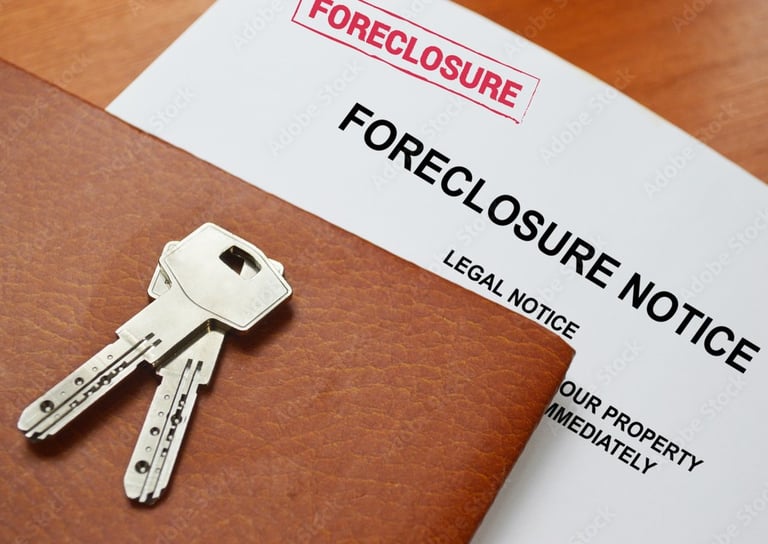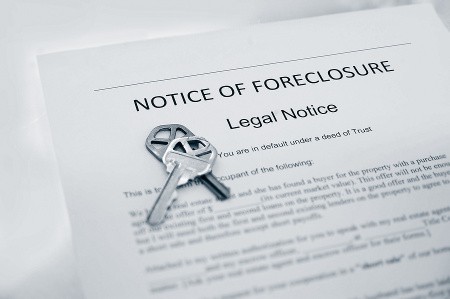Understanding Foreclosure in Texas: A Comprehensive Guide
This guide breaks down the steps involved, the types of foreclosures, your rights, and how you might avoid losing your home
13 min read


Key Takeaways
Foreclosure in Texas can be initiated through judicial or non-judicial processes, affecting the speed and cost of the proceedings.
Homeowners receive protections and rights during foreclosure, including the opportunity to request postponements and loss mitigation options.
Once a foreclosure sale occurs in Texas, there is no redemption period for homeowners, emphasizing the importance of addressing payment issues promptly.
What is Foreclosure?
Foreclosure is a legal process that allows lenders to recover the balance of a loan from borrowers who have defaulted on their mortgage payments. When a borrower fails to meet their mortgage obligations, the lender can initiate foreclosure to force the sale of the collateral property and satisfy the outstanding debt. The foreclosure process in Texas begins when a mortgage loan becomes delinquent for over 120 days.
The primary reasons for foreclosure are monetary default, when payments are missed, or technical default, when other mortgage conditions are not met.
In Texas, foreclosure can be either judicial or non-judicial. Judicial foreclosure involves court proceedings, where the lender files a lawsuit to obtain permission to sell the property. Conversely, non-judicial foreclosure allows the lender to sell the property without court intervention, provided that the deed of trust includes a power of sale clause. These distinctions significantly impact the foreclosure process and homeowner rights
Overview of Texas Foreclosure Laws
Texas foreclosure laws are designed to create a balanced framework that protects both lenders and borrowers when a mortgage loan goes into default. These laws outline the specific procedures that must be followed to foreclose on a property, ensuring that the process is fair and transparent.
One of the key aspects of Texas foreclosure laws is the requirement for lenders to provide borrowers with proper notice before initiating foreclosure proceedings. This includes a notice of default, which informs the borrower of missed mortgage payments and gives them a chance to rectify the situation. Additionally, a notice of sale must be sent, detailing the date, time, and location of the foreclosure sale.
The laws also specify the timeframes within which these notices must be given, providing borrowers with a window to take corrective action. For instance, after receiving a notice of default, homeowners typically have at least 20 days to cure the default. If they fail to do so, the lender can then issue a notice of sale, which must be sent at least 21 days before the scheduled auction.
Understanding these foreclosure laws is crucial for both lenders and borrowers. For lenders, it ensures compliance with legal requirements, reducing the risk of wrongful foreclosure claims. For borrowers, it provides an opportunity to address payment issues and explore options to avoid foreclosure. By being well-informed about Texas foreclosure laws, both parties can navigate the foreclosure process more effectively and protect their respective interestss
Types of Foreclosures in Texas
Texas foreclosures occur through two primary methods: judicial and non-judicial. Each method has distinct procedures and implications for lenders and homeowners, affecting the duration, cost, and the borrower's ability to reclaim their property.
Judicial foreclosures, involving a lender's lawsuit to obtain a court order for property sale, are less common in Texas due to their length and expense, particularly when considering Texas foreclosure laws.
Non-judicial foreclosures are more prevalent due to their speed and lower cost. They bypass court involvement if the deed of trust includes a power of sale clause, enabling the lender to proceed with the sale of nonjudicial foreclosures.
Judicial Foreclosure
Judicial foreclosure in Texas is initiated when a lender files a civil lawsuit against the borrower to recover the outstanding loan balance. If the borrower does not respond to the lawsuit, the lender automatically wins, and the court orders the sale of the property.
However, if the borrower contests the foreclosure, the court reviews the evidence before making a decision. If the lender prevails, the judge will issue an order for the property to be sold at auction.
This process ensures that all parties have an opportunity to present their case but can be lengthy and expensive.
Non-Judicial Foreclosure
Non-judicial foreclosure is preferred by most Texas lenders for its efficiency and lower costs. It allows property sale without court involvement if the deed of trust includes a power of sale clause, which is common in most residential mortgage loans in Texas. The nonjudicial foreclosure process enables this streamlined approach.
The non-judicial foreclosure process must adhere to specific state statutes, including sending notices and holding the sale at a designated location. Foreclosure sales in Texas are usually held on the first Tuesday of each month at the county courthouse.
If any procedural requirements are not met, the foreclosure can be rescinded. This method is advantageous for lenders due to its speed but requires strict compliance with legal guidelines to avoid wrongful foreclosure claims
Understanding Mortgage Payments
Mortgage payments are a critical aspect of homeownership, typically made on a monthly basis. These payments are composed of four main components: principal, interest, taxes, and insurance, commonly referred to as PITI. The principal is the amount borrowed, while the interest is the cost of borrowing that money. Taxes and insurance are additional costs that are often included in the monthly payment to ensure they are paid on time.
When a borrower fails to make their mortgage payments, it can lead to serious consequences, including the acceleration of the loan. Acceleration is a process where the lender declares the entire loan balance due immediately, rather than just the missed payments. This step is often a precursor to foreclosure proceedings, as it signifies that the lender is taking formal action to recover the outstanding debt.
Understanding the components of mortgage payments and the importance of timely payments can help homeowners manage their finances better and avoid the risk of foreclosure. If financial difficulties arise, it's crucial to communicate with the lender as early as possible to explore potential solutions, such as loan modifications or forbearance, which can provide temporary relief and prevent the situation from escalating to foreclosure
The Texas Foreclosure Process Step-by-Step
Homeowners facing foreclosure in Texas must understand the process, which begins with a notice of default and progresses through stages like the notice of sale and the foreclosure sale. Each step involves specific legal requirements and timelines for both lender and borrower.
The following sections detail each step to clarify what to expect
Default and Acceleration
Default occurs when a borrower fails to make their mortgage payments or violates other terms of the loan agreement. This can include missing a few mortgage payments or failing to maintain the property as required by the loan terms. When a default happens, the lender has the right to take action to protect their financial interest.
One of the primary actions a lender can take is acceleration. Acceleration is the process by which the lender declares the entire loan balance due immediately, rather than just the overdue payments. This is a significant step in the foreclosure process, as it indicates that the lender is moving towards recovering the full amount owed through the sale of the property.
In Texas, the lender must provide the borrower with a notice of default and intent to accelerate. This notice gives the borrower a specified period of time to cure the default, typically at least 20 days. If the borrower fails to address the default within this timeframe, the lender can proceed with issuing a notice of sale and moving forward with foreclosure.
Understanding the concepts of default and acceleration is essential for homeowners. It highlights the importance of staying current on mortgage payments and being aware of the potential consequences of defaulting on a loan. By recognizing these terms and their implications, borrowers can take proactive steps to manage their mortgage obligations and avoid the risk of foreclosure.
Notice of Default
The foreclosure process in Texas starts with the lender sending a notice of default to the borrower. This notice informs the borrower that they are in default on their mortgage payments and specifies the overdue amount and the deadline to make the payment. Homeowners in Texas have a minimum of 20 days to cure the default after receiving this notice. During this period, the borrower has the opportunity to make up for the missed payments and avoid further foreclosure action.
If the borrower fails to cure the default within the given timeframe, the lender may issue a notice of acceleration, demanding immediate payment of the total outstanding debt. This step escalates the process, bringing the lender closer to selling the property to recover the loan balance.
Recognizing the notice of default's implications and acting promptly can prevent foreclosure.
Notice of Sale
Following the notice of default, the notice of sale is the next critical step. The Notice of Sale must also be filed with the county clerk to ensure compliance with legal notification requirements. Texas lenders must send this notice, which includes essential details such as the sale date, time, location, and the homeowner's military status.
It must be sent at least 21 days before the scheduled auction to give the homeowner ample time to prepare. This notice marks the final warning before the property is sold, making it a crucial juncture in the foreclosure process.
Foreclosure Sale
The foreclosure sale is the culmination of the foreclosure process, where the property is sold to the highest bidder. In Texas, foreclosure sales usually occur on the first Tuesday of each month at the county courthouse. A Notice of Trustee's Sale must be filed and publicly posted at least 21 days before the sale, providing details about the debt and timing of the sale. The sale must commence by the time indicated in the notice. It should not start later than three hours after that scheduled time.
The property is auctioned off to the highest bidder during the foreclosure sale. This bidder can either be the foreclosing lender or a third party. If a third party bids higher than the owed amount, the borrower receives any surplus from the sale.
A deed is then delivered to the winning bidder, signifying the transfer of ownership. This step is crucial as it determines the final outcome for both the borrower and the buyer.
Borrower Rights During Foreclosure
Texas borrowers have specific rights during the foreclosure process that provide them with several protections and opportunities to avoid losing their homes. One of these rights includes receiving a preforeclosure breach letter, which outlines the borrower's default and possible solutions. Borrowers can also request a one-time postponement of their foreclosure sale, which must be made at least seven days in advance. This postponement can provide additional time to negotiate with the lender or explore other options.
Additionally, homeowners must be informed in writing about loss mitigation options within 45 days after a missed payment. Borrowers can request a repayment plan at least seven days before the foreclosure sale if they can demonstrate their financial capability. If the request is accepted, the lender must pause the foreclosure process to review the application.
These rights and protections under federal and state laws are designed to provide borrowers with a fair chance to avoid foreclosure and resolve their mortgage servicer issues
Reinstating the Loan Before Foreclosure
In Texas, borrowers have the opportunity to reinstate their loan and halt the foreclosure process within 20 days of receiving the notice of default. This involves paying the overdue amount and any associated fees to bring the loan current. Reviewing loan documents thoroughly is essential to verify the specific conditions related to reinstatement. The deed of trust may also grant additional time beyond the statutory 20-day period for loan reinstatement.
If a borrower fails to secure a signed reinstatement or modification agreement, it could lead to future disputes over unpaid amounts. Moreover, accepting payments without a formal reinstatement agreement might imply that the lender has forfeited the right to accelerate the loan.
Understanding these nuances is vital for borrowers to navigate the reinstatement process effectively and avoid complications
Deficiency Judgments in Texas
A deficiency judgment is a legal action taken by lenders to recover the shortfall when the sale proceeds from a foreclosure are less than the loan balance. In Texas, lenders must file a lawsuit to obtain a deficiency judgment after a nonjudicial foreclosure. Borrowers have two years after the foreclosure sale to contest a deficiency judgment. The statute of limitations for lenders to file for a deficiency judgment is generally two years, with an extended period of four years for federally-insured lenders.
Borrowers can request that the fair market value of the property be considered when determining the deficiency amount. Texas Property Code Section 51.003 outlines the regulations regarding deficiency judgments, including the requirement to consider the fair market value if the foreclosure sale price is below it.
Knowing these foreclosure laws can help borrowers protect their interests and potentially reduce their owed amounts after foreclosure
No Redemption Period After Foreclosure
Texas does not provide a general right of redemption following a foreclosure sale. Once a foreclosure sale occurs, the homeowner loses all rights to the property immediately and cannot reclaim it.
The absence of a redemption period underscores the importance of addressing foreclosure issues promptly and exploring all available options before the foreclosure sale occurs
Eviction Following Foreclosure
The eviction process starts after a foreclosure sale when the new owner files for eviction. The county constable's office issues eviction notices and schedules the court hearing. The process can be completed within 60 days from the initial notice.
After a judge's ruling, the former homeowner is given five days to vacate the premises or appeal. If the former homeowner does not leave within this period, a notice is posted allowing 24 hours for them to move out
Special Considerations for Home Equity Loans
Home equity loans in Texas have unique foreclosure considerations. In some cases, judicial foreclosure is mandatory, requiring a court order specifying the sale date, ensuring judicial supervision and added scrutiny.
Expedited foreclosure can also occur with court permission, allowing for a quicker process in specific cases, such as with home equity loans. If a borrower responds to the foreclosure application, the court sets a hearing to decide if the lender can proceed with the foreclosure. Borrowers have 38 days from the date of mailing to respond.
No deficiency judgments are allowed after the foreclosure of a home equity loan in Texas, offering borrowers some financial relief. Knowing these rules helps borrowers navigate the foreclosure process more effectively
Statute of Limitations for Foreclosure
Texas law imposes a four-year statute of limitations for filing foreclosure actions, starting from the cause of action, usually the note's maturity date. If an optional acceleration clause is included, the period begins when the lender exercises that option. Thus, lenders have a limited window to initiate foreclosure proceedings.
However, a lender can reset the statute of limitations by rescinding its acceleration and notifying the borrower accordingly. This action restores the original maturity date and resets the limitations period.
Borrowers should be aware of these timelines to understand their rights and the potential for delaying foreclosure actions
Getting Legal Help
The foreclosure process can be complex, and legal help is often essential. Borrowers should consult a foreclosure attorney to explore potential defenses and understand their rights. Last-minute bankruptcies can stop or void foreclosures, providing immediate relief.
Filing for Chapter 13 bankruptcy can create a structured repayment plan for missed mortgage payments and temporarily suspend foreclosure actions, allowing homeowners to catch up on a few mortgage payments. State assistance programs like the Texas Hardest Hit Fund can offer financial help for homeowners struggling with mortgage payments due to economic hardship.
Resources like the Texas Department of Housing and Community Affairs provide valuable information and support
Summary
Understanding the foreclosure process in Texas is crucial for homeowners facing financial difficulties and potential foreclosure. We've explored the different types of foreclosures, the step-by-step foreclosure process, borrower rights, and various options to avoid foreclosure. By being informed, homeowners can better navigate this challenging situation and take proactive measures to protect their homes and financial well-being.
Taking early action, communicating with lenders, and seeking legal help are vital steps in addressing foreclosure. Whether through loan modifications, forbearance, or other alternatives, homeowners have several options to explore. Remember, knowledge is power, and being well-informed can make a significant difference in overcoming the challenges of foreclosure
Frequently Asked Questions
What is the first step in the foreclosure process in Texas?
The first step in the foreclosure process in Texas is the notice of default, wherein the lender notifies the borrower of missed payments and provides at least 20 days to rectify the default.
Can a homeowner in Texas reclaim their property after a foreclosure sale?
Homeowners in Texas cannot reclaim their property after a foreclosure sale, as the state does not allow for a general redemption period following such an event.
What are some options to avoid foreclosure?
To avoid foreclosure, homeowners can consider loan modifications, forbearance, short sales, or deeds in lieu of foreclosure. These options can provide necessary relief and potentially help retain homeownership. You can also list your house with a realtor, but in most cases, there isn't enough time prior to the auction date to complete the sale. Selling your house to a cash buyer is another option to avoid foreclosure. Grace Hill Solutions can help you understand all these options at no cost and give you the information you need to make the decision that is best for you.
How long does a lender have to file for a deficiency judgment after a foreclosure sale in Texas?
A lender has two years to file for a deficiency judgment after a foreclosure sale in Texas. It is essential to be aware of this timeline to understand potential financial implications.
What should a borrower do if they receive a notice of default?
A borrower receiving a notice of default should promptly communicate with their lender to explore repayment options and seek legal advice to prevent further foreclosure actions. Taking immediate action is crucial to mitigate potential consequences.
Please reach out to us at Grace Hill Solutions to help guide you through all available options at no cost










Options to avoid Foreclosure
For homeowners facing foreclosure, there are several options available to avoid losing their property. Early communication with lenders is crucial, as it enhances the possibility of finding solutions such as repayment plans or loan modifications. A loan modification can alter the terms of the mortgage to make payments more manageable, which may help prevent foreclosure. Requesting a forbearance allows homeowners to temporarily pause or reduce mortgage payments during financial difficulties.
Another option is a short sale, which permits selling the home for less than the mortgage owed, with lender approval. This approach is generally less damaging to the homeowner's credit than foreclosure.
Additionally, transferring property ownership through a deed in lieu of foreclosure can provide relief from mortgage debt while preventing a public auction. Exploring these options can offer viable alternatives to foreclosure and help homeowners retain control over their financial situation.
At Grace Hill Solutions, we'll help you communicate with your lender and understand all available options at no cost
